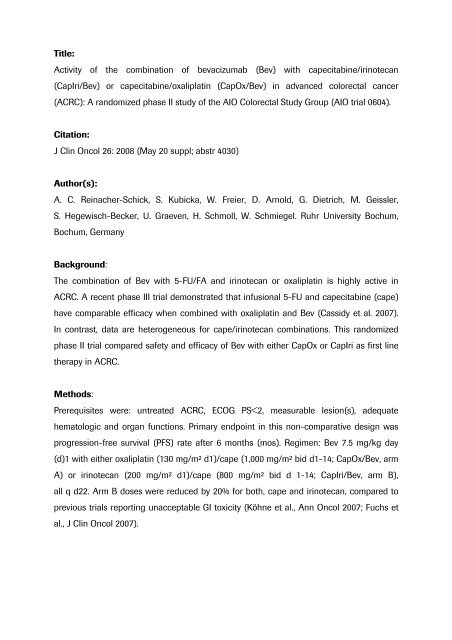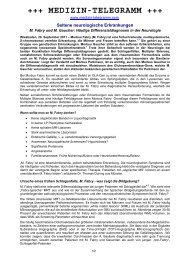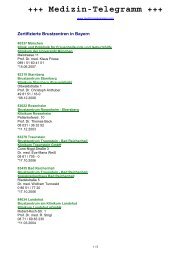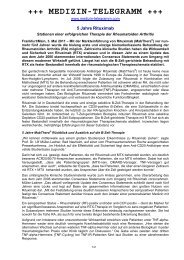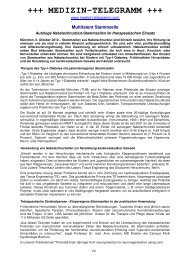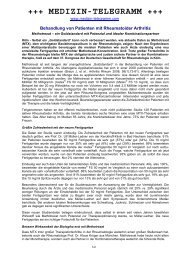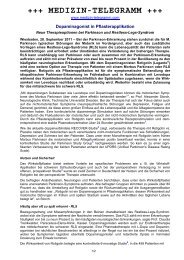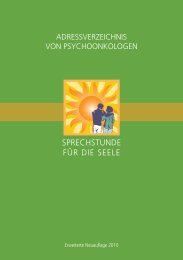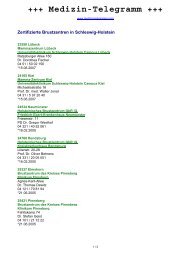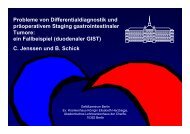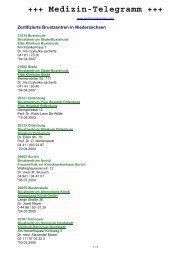FINAL_Reinacher_Abstract 4030_formatiert - Medizin-telegramm.com
FINAL_Reinacher_Abstract 4030_formatiert - Medizin-telegramm.com
FINAL_Reinacher_Abstract 4030_formatiert - Medizin-telegramm.com
You also want an ePaper? Increase the reach of your titles
YUMPU automatically turns print PDFs into web optimized ePapers that Google loves.
Title:<br />
Activity of the <strong>com</strong>bination of bevacizumab (Bev) with capecitabine/irinotecan<br />
(CapIri/Bev) or capecitabine/oxaliplatin (CapOx/Bev) in advanced colorectal cancer<br />
(ACRC): A randomized phase II study of the AIO Colorectal Study Group (AIO trial 0604).<br />
Citation:<br />
J Clin Oncol 26: 2008 (May 20 suppl; abstr <strong>4030</strong>)<br />
Author(s):<br />
A. C. <strong>Reinacher</strong>-Schick, S. Kubicka, W. Freier, D. Arnold, G. Dietrich, M. Geissler,<br />
S. Hegewisch-Becker, U. Graeven, H. Schmoll, W. Schmiegel. Ruhr University Bochum,<br />
Bochum, Germany<br />
Background:<br />
The <strong>com</strong>bination of Bev with 5-FU/FA and irinotecan or oxaliplatin is highly active in<br />
ACRC. A recent phase III trial demonstrated that infusional 5-FU and capecitabine (cape)<br />
have <strong>com</strong>parable efficacy when <strong>com</strong>bined with oxaliplatin and Bev (Cassidy et al. 2007).<br />
In contrast, data are heterogeneous for cape/irinotecan <strong>com</strong>binations. This randomized<br />
phase II trial <strong>com</strong>pared safety and efficacy of Bev with either CapOx or CapIri as first line<br />
therapy in ACRC.<br />
Methods:<br />
Prerequisites were: untreated ACRC, ECOG PS
Results:<br />
From July 2005 to Oct 2006, 255 patients (pts) were randomised. Patient characteristics<br />
(arm A/B): Median age 64/65 yrs, male 67%/68%, ECOG 0/1/2 52/45/3% and 52/45/2%,<br />
colon 60%/64%, rectum 40%/36%, respectively. Data are available for 244 (124/120) pts.<br />
Treatment characteristics (arm A/B): A total of 965/1069 cycles (median 8/9 cycles) have<br />
been administered. For 198 pts the end of treatment has been documented: 34%<br />
(30%/38%) due to progression, 29% (41%/18%) due to toxicity, 20% (16%/24%) because<br />
of pts' decision. Most <strong>com</strong>mon CTC gr. 3/4 toxicities of pts, arm A/B: Diarrhea 19%/15%,<br />
hand-foot-syndrome 10%/7%, peripheral neuropathy 23%/0% Tumor response rates<br />
(CR+PR) were 54%/55%, tumor control rates (incl. SD) were 79%/80%. PFS rate at 6 mos<br />
were 78%/84%, median PFS 9.9/12.5 mos.<br />
Conclusions:<br />
Both regimen are highly active and safe. The absence of neuropathy favours the<br />
CapIri/Bev <strong>com</strong>bination. Interestingly, the dose reduction of CapIri seemingly improves<br />
tolerability without <strong>com</strong>promising efficacy.


